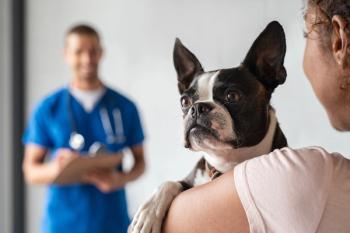
Q&A: Im ready to work on exotic pets! Where do I start?
Dip your toe in exotics with these first steps for veterinarians ready to delve into caring for pets that are less commonbut no less lovable.
Thinking of treating birds and other exotic pets at your veterinary hospital? Exotics can be a great practice builder. However, if you're considering seeing exotics there are many factors to consider before you commit to adding feathers and scales to your patient list.
Equip yourself
Like any other service your hospital offers, exotic pet care-whether birds, small mammals (ferrets, rabbits, rodents), reptiles, amphibians, wildlife or uncommon species (hedgehogs, pot-bellied pigs, sugar gliders, prairie dogs)-will only be worth it if you can charge appropriately for it. And the way to feel justified charging for exotic pet services is to spend time studying bird and exotic animal diseases and treatment and to acquire basic equipment to diagnose and treat these pets.
Dr. Laurie Hess: How the team can help market your practice-a must if you see exotics
Laurie Hess, DVM, DABVP (Avian) is here to remind you that images and words from the front line tell compelling stories. She says no one is better poised to collect shareable moments that veterinary technicians.
Of course, the amount you spend on equipment will be proportional to the depth of exotic pet care you aim to provide, but here's some basic equipment you'll need:
> Small syringes (insulin- and tuberculin-sized) with small needles (33- and 25-gauge, respectively)
> Microtainer tubes and microhematocrit tubes for blood collection (available from most veterinary laboratories)
> A microcentrifuge to spin down microtainer tubes
> A scale that weighs in grams
> Support from a veterinary laboratory that tests small blood samples from exotic pets
> A microscope and Gram stain
> An infant-sized stethoscope
> A heated cage to provide oxygen and nebulized drugs with narrow bar spacing or a Plexiglas enclosure to prevent escape of small exotic pets
> Small-gauge intravenous catheters, endotracheal tubes and masks to deliver anesthesia and oxygen
> Metal gavage feeding tubes: curved for birds and straight for reptiles
> An infusion pump that can deliver fractions of a milliliter of fluid per minute
> A variety of towels, from washcloths to bath-sized, to restrain pets
> A nearby pharmacy that can compound drugs into small volumes
Once you've set yourself up with basic equipment and educated yourself with a general knowledge of bird and exotic pet diseases and treatment, it's a matter of time and practice to make exotic pet services profitable.
For reference, I've been treating solely birds and exotics for 18 years and now have an active client base of about 3,500 exotic pet owners. Depending on the species I'm treating, my average transaction fee is about $375. So, done correctly, exotic pets can be quite profitable.
On the next page, find resources to educate yourself and your team on exotic pet care.
Educate yourself
Above are great tools for practice, but you know your best tool in practice is your brain. Here are my go-to resources for learning about, diagnosing and training to treat more exotic pets:
Professional associations and websites
> Association of Avian Veterinarians (
> Association of Exotic Mammal Veterinarians (
> Association of Reptile and Amphibian Veterinarians (
> American Association of Zoo Veterinarians (
> American Society of Lab Animal Practitioners (
> American Association for Laboratory Animal Science (
Online groups about exotics pets
> Exotic animal message board on Veterinary Information Network (
> Exotic DVM Veterinary Forum (
> BackYardChickens.com
> MyPetChicken.com
Journals
> Journal of Avian Medicine and Surgery
> Journal of Exotic Pet Medicine
> Journal of Herpetological Medicine and Surgery
> Journal of Zoo and Wildlife Medicine
> Veterinary Clinics of North America: Exotic Animal Practice
Textbooks
Carpenter JW (ed). Exotic Animal Formulary, 4th Ed. St Louis, MO. Elsevier Inc, 2013.
Harrison GJ, Lightfoot TL (eds). Clinical Avian Medicine, Vol 1 & 2. Palm Beach, FL. Spix Publishing Inc, 2006.
Mader D (ed). Reptile Medicine and Surgery, 2nd Ed. St Louis, MO. Elsevier Inc, 2006.
Quesenberry KE, Carpenter JW (eds). Ferrets, Rabbits, and Rodents: Clinical Medicine and Surgery, 3rd Ed. St Louis, MO. Elsevier Inc, 2012.
Ritchie BW, Harrison GJ, Harrison LR (eds). Avian Medicine: Principles and Application. Lake Worth, FL. Wingers Publishing, 1994.
Wright KM, Whitaker BR (eds). Amphibian Medicine and Captive Husbandry. Malabar, FL. Krieger Publishing, 2001.
Rubel GA, Isenbugel E, Wolvekamp P (eds). Atlas of Diagnostic Radiology of Exotic Pets. Philadelphia, PA. WB Saunders, 1991.
Capelleo V, Lennox AM (eds). Clinical Radiology of Companion Mammals. Ames, IO. Wiley-Blackwell, 2008.
Dr. Laurie Hess, DABVP (avian), is the owner of Veterinary Center for Birds & Exotics in Bedford Hills, New York.
Newsletter
From exam room tips to practice management insights, get trusted veterinary news delivered straight to your inbox—subscribe to dvm360.






